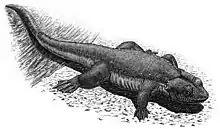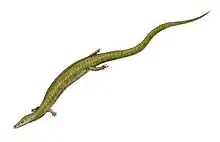| Kuwajima Formation | |
|---|---|
| Stratigraphic range: | |
| Unit of | Tetori Group |
| Sub-units | Lower Member, Upper Member |
| Underlies | Akaiwa Formation |
| Overlies | Gomijima Formation |
| Lithology | |
| Primary | Sandstone, Mudstone |
| Location | |
| Country | |
The Kuwajima Formation is an Early Cretaceous geologic formation in Japan. Its precise age is uncertain due to a lack of identifying fossils, and it was previously considered likely Valanginian to Hauterivian in age.[1] However, it is now considered to probably be Barremian in age.[2] Dinosaurs and other vertebrates has been recovered from the Kaseki-kabe "Fossil-bluff" locality in the uppermost part of the formation.[3]
The multituberculate mammals Hakusanobaatar matsuoi and Tedoribaatar reini are known from the Kuwajima Formation.[4] A member of Tritylodontidae, Montirictus kuwajimaensis, has also been recovered from the unit.[5]
Vertebrate Paleobiota
Fish
| Fish reported from the Kuwajima Formation | ||||||
|---|---|---|---|---|---|---|
| Genus | Species | Location | Stratigraphic position | Material | Notes | Images |
| Sinamia | S. kukurihime | Mostly complete skeleton | An amiiform fish related to bowfins | |||
| Tetoriichthys | T. kuwajimaensis | The oldest record of Osteoglossiform | ||||
Amphibians
| Amphibians reported from the Kuwajima Formation | ||||||
|---|---|---|---|---|---|---|
| Genus | Species | Location | Stratigraphic position | Material | Notes | Images |
| Shirerpeton[6] | S. isajii | Kaseki-kabe | Facies III | Partial disarticulated skull | Albanerpetontid | |
| Anura | Indeterminate | Isolated longbone, as well as a partial skeleton "composed of a few skull elements and several postcranial bones, including the femur, ilium, and vertebrae"[7] | Partial skeleton belongs to a basal frog that lies outside of Neobatrachia.[7] | |||
Choristoderes
| Choristoderes reported from the Kuwajima Formation | ||||||
|---|---|---|---|---|---|---|
| Genus | Species | Location | Stratigraphic position | Material | Notes | Images |
| Monjurosuchus | Indeterminate | Kaseki-kabe | Facies III |
| ||
| Neochoristodera[8] | Indeterminate | Facies I | The first report of a neochoristodere from Japan | |||
| Choristodera | Indeterminate | Kaseki-kabe | Facies III | |||
Squamates
| Squamates reported from the Kuwajima Formation | ||||||
|---|---|---|---|---|---|---|
| Genus | Species | Location | Stratigraphic position | Material | Notes | Images |
| Asagaolacerta | A. tricuspidens | Kaseki-kabe | Facies III | "An association of skull, jaws and postcranial bones of a small lizard with facetted tricuspid teeth, possibly a right maxilla" |
| |
| Hakuseps | H. imberis | Kaseki-kabe | Facies III | An almost complete left dentary | ||
| Kaganaias | K. hakusanensis | Kaseki-kabe | Facies III | "Part and counterpart of articulated partial skeleton comprising parts of the dors. vert. series and parts of the tail, pelvis, and hind limbs" | ||
| Kuroyuriella | K. mikikoi | Kaseki-kabe | Facies III | "A disarticulated skull on four originally conjoined blocks, an association on two small blocks" | ||
| Kuwajimalla[9] | K. kagaensis | Kaseki-kabe | Facies III | |||
| Sakurasaurus | Indeterminate | Kaseki-kabe | Facies III | "Small block with disarticulated association of skull bones, vertebrae, ribs, pelvis and hindlimb bones" | ||
| Paramacellodidae | Indeterminate | Kaseki-kabe | Facies III | |||
| Squamata | Indeterminate | Kaseki-kabe | Facies III | Five distinct taxa | ||
Dinosaurs
| Dinosaurs reported from the Kuwajima Formation | ||||||
|---|---|---|---|---|---|---|
| Genus | Species | Location | Stratigraphic position | Material | Notes | Images |
| Albalophosaurus[3] | A. yamaguchiorum | Kaseki-kabe | Facies III | Partial skull and lower jaws | ||
| Dromaeosauridae | Indeterminate | Kaseki-kabe | Facies III | |||
| Enantiornithes | Indeterminate | Kaseki-kabe | Facies III | |||
| Ornithischia[10] | Indeterminate | Right dentary, left maxilla, isolated teeth | Distinct from Albalophosaurus | |||
| Sauropoda ("Oharasisaurus") | Indeterminate | Kaseki-kabe | Facies III | Tooth[11] | ||
| Styracosterna[10] | Indeterminate | Maxillary and dental teeth | ||||
Mammaliamorphs
| Mammaliamorphs reported from the Kuwajima Formation | ||||||
|---|---|---|---|---|---|---|
| Genus | Species | Location | Stratigraphic position | Material | Notes | Images |
| Hakusanobaatar[4] | H. matsuoi | Kaseki-kabe | Facies III | Dentary fragments and teeth | Eobaatarid | |
| Hakusanodon[12] | H. archaeus | Kaseki-kabe | Facies III | Eutriconodont | ||
| Montirictus[5] | M. kuwajimaensis | Kaseki-kabe | Facies III | Tritylodontid | ||
| Tedoribaatar[4] | T. reini | Kaseki-kabe | Facies III | "Fragment of right lower jaw with p4" | Eobaatarid | |
| Multituberculata | Indeterminate | Kaseki-kabe | Facies III | |||
Invertebrate Paleobiota
| Invertebrates reported from the Kuwajima Formation | ||||||
|---|---|---|---|---|---|---|
| Genus | Species | Location | Stratigraphic position | Material | Notes | Images |
| Nipponoridium | B. matsuoi | Kaseki-Kabe | Mimarachnid hemipteran | |||
| Nipponohagla | N. kaga | Prophalangopsid | ||||
| Kagapsychops | K. araneus | Psychopsid | ||||
See also
References
- ↑ Fujita, M. (2003). "Geological age and correlation of the vertebrate-bearing horizons in the Tetori Group". Memoir of the Fukui Prefectural Dinosaur Museum. 2: 3–14.
- ↑ Amiot, Romain; Kusuhashi, Nao; Saegusa, Haruo; Shibata, Masateru; Ikegami, Naoki; Shimojima, Shizuo; Sonoda, Teppei; Fourel, François; Ikeda, Tadahiro; Lécuyer, Christophe; Philippe, Marc; Wang, Xu (2021-01-01). "Paleoclimate and ecology of Cretaceous continental ecosystems of Japan inferred from the stable oxygen and carbon isotope compositions of vertebrate bioapatite". Journal of Asian Earth Sciences. 205: 104602. Bibcode:2021JAESc.20504602A. doi:10.1016/j.jseaes.2020.104602. ISSN 1367-9120.
- 1 2 Ohashi, T.; Barrett, P. M. (2009). "A new ornithischian dinosaur from the Lower Cretaceous Kuwajima Formation of Japan". Journal of Vertebrate Paleontology. 29 (3): 748–757. doi:10.1671/039.029.0306. S2CID 128546047.
- 1 2 3 Kusuhashi, Nao (September 2008). "Early Cretaceous Multituberculate Mammals from the Kuwajima Formation (Tetori Group), Central Japan". Acta Palaeontologica Polonica. 53 (3): 379–390. doi:10.4202/app.2008.0302. ISSN 0567-7920.
- 1 2 Hiroshige Matsuoka, Nao Kusuhashi and Ian J. Corfe (2016). "A new Early Cretaceous tritylodontid (Synapsida, Cynodontia, Mammaliamorpha) from the Kuwajima Formation (Tetori Group) of central Japan". Journal of Vertebrate Paleontology. Online edition:
- ↑ Matsumoto, Ryoko; Evans, Susan E. (2018-01-03). "The first record of albanerpetontid amphibians (Amphibia: Albanerpetontidae) from East Asia". PLOS ONE. 13 (1): e0189767. Bibcode:2018PLoSO..1389767M. doi:10.1371/journal.pone.0189767. ISSN 1932-6203. PMC 5752013. PMID 29298317.
- 1 2 Mizukami, Ayano; Matsumoto, Ryoko; Wani, Ryoji; Evans, Susan E. (2023-01-04). "A Three-Dimensionally Preserved Frog (Amphibia, Anura) from the Lower Cretaceous Kuwajima Formation, Tetori Group, Ishikawa Prefecture, Japan". Paleontological Research. 27 (3). doi:10.2517/PR210031. ISSN 1342-8144.
- ↑ Matsumoto, Ryoko; Manabe, Makoto; Evans, Susan E. (2015-07-04). "The first record of a long-snouted choristodere (Reptilia, Diapsida) from the Early Cretaceous of Ishikawa Prefecture, Japan". Historical Biology. 27 (5): 583–594. doi:10.1080/08912963.2014.898296. ISSN 0891-2963.
- ↑ Evans, Susan E.; Manabe, Makoto (March 2008). "An early herbivorous lizard from the Lower Cretaceous of Japan". Palaeontology. 51 (2): 487–498. doi:10.1111/j.1475-4983.2008.00759.x. ISSN 0031-0239.
- 1 2 Barrett, Paul M.; Ohashi, Tomoyuki (October 2015). "Ornithischian dinosaur material from the Kuwajima Formation (Tetori Group: Lower Cretaceous) of Ishikawa Prefecture, Japan". Historical Biology. 28 (1–2): 280–288. doi:10.1080/08912963.2015.1032273. ISSN 0891-2963. S2CID 128909019.
- ↑ MATSUOKA H. (2000). Fossils of the Kuwajima "Kasekikabe" (Fossil Bluff): a scientific report on a Neocomian (Early Cretaceous) fossil assemblage of the Kuwajima Formation, Tetori Group, Ishikawa, Japan.
- ↑ Rougier, Guillermo W.; Isaji, Shinji; Manabe, Makoto (2007). "An Early Cretaceous Mammal from the Kuwajima Formation (Tetori Group), Japan, and a Reassessment of Triconodont Phylogeny". Annals of Carnegie Museum. 76 (2): 73. doi:10.2992/0097-4463(2007)76[73:aecmft]2.0.co;2. ISSN 0097-4463.
This article is issued from Wikipedia. The text is licensed under Creative Commons - Attribution - Sharealike. Additional terms may apply for the media files.

